| |
Home
Famous and Fascinating Women in History
Frontiersmen and Women
The World's Greatest Composers
Famous Women Spies
Great Authors of the World
Generals and other Noteworthy People
from the Civil War
The Presidents of the United States
The First Ladies of the United States
Homes and Monuments of and to
Famous People
Historical People and Events by Month for Each Day of the Year!
Famous Figures in Black History
The Calvert Family and the Lords Baltimore
Understanding the American Revolution and its People
Everything Beatles!
Everything Maryland! |
| |
|
 
|
| |  |  |
 |  | 
Millard Fillmore: His Life and Homes
By
John T. Marck
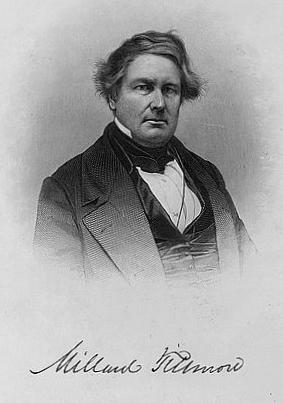
Birthplace and Early Life
Millard Fillmore was born January
7, 1800 in a log cabin in an area known as Locke, in Cayuga County,
New York. The original birthplace log cabin no longer stands today,
having been torn down in 1852.
The second of eight children, Fillmore grew up
in a poverty-stricken family whose small farm could not support them.
Fillmore endured the hardships of farm life, and at the age of 15, was
apprenticed to a cloth maker, which was brutal, just short of a type
of slavery. Hating this work, he borrowed thirty dollars to pay his
obligation to the cloth maker, and now free, quit, and walked 100
miles to get back to his family's
home.
Fillmore was obsessed with
educating himself, and read every book he could find. Teaching himself
to read, he sometimes stole books, as he could not afford to buy them.
Still obsessed with his education, he attended school in a nearby
town, and his teacher, Abigail Powers, encouraged his studies. In
time, she became the most influential and trusted person in his life.
At this time she was 19 years old, not quite two years older than
Millard. In 1826, Fillmore married Abigail Powers. Soon
thereafter he received a clerkship with a local judge, and was
admitted to the bar. In 1830, Fillmore moved his law practice to
Buffalo, and as an associate of a Whig politician, Thurlow Weed, he
held state office and for 8 years was a member of the House of
Representatives. In 1848, while serving as the Comptroller of New
York, he was elected vice president of the United States under
President Zachary Taylor.
Birthplace Replica Log Cabin, Moravia, New York
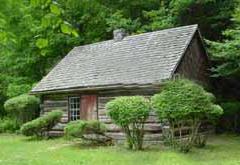
As Fillmore's
original birthplace was torn down, the Millard Fillmore
Memorial Association in 1965, used materials from a similar log cabin
to construct this replica that commemorates the President, located in
the Fillmore Glen State Park. This park consists of 938 acres, and
showcases a deep limestone and shale glen with five waterfalls, a
stone walled swimming pool, campground, pavilion and picnic areas.
The history of Moravia is an
interesting one, as it was once the site of an Indian Village. Between
1783 and 1790, the land was used by settlers to harvest hay, and
originally called Owasco Flats. On March 8, 1799, Cayuga County was
formed from Onondaga County. On March 9, one day later, the Town of
Sempronius was formed that included the area that became Moravia,
which became a town on March 30, 1833. Located at the tip of Owasco
Lake, Moravia was incorporated in 1837 and reincorporated in 1859 when
its boundaries were expanded.
Fillmore's
Presidency
Fillmore was thrust into the
Presidency upon the sudden death of President Zachary Taylor. As vice
president, Fillmore presided over the months of debates concerning the
Compromise of 1850. Although Fillmore made no public comments as to
his position on the Compromise of 1850, he did tell President Taylor,
a few days before his death, that if there would be a tie vote on this
bill, he would vote in its favor.
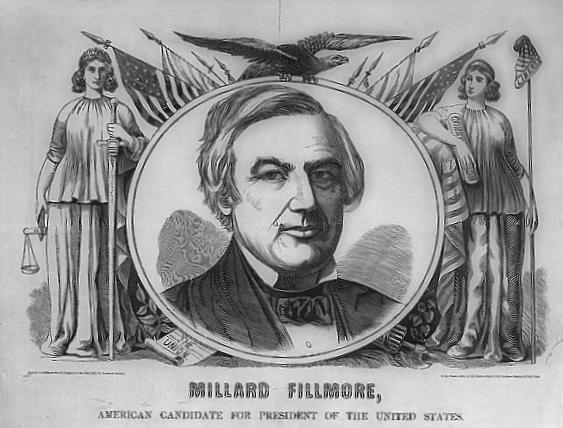
Upon Taylor's
death in 1850, Fillmore became the 13th President of the
United States; the first president to be born in the 19th
century, and the only president born in central New York. When
Fillmore took over as President, there was an immediate shift in the
administration. Those members serving as Taylor's
Cabinet resigned, so Fillmore appointed Daniel Webster as Secretary of
State, and in doing so, demonstrated his alliance with the moderate
Whig party who favored the Compromise of 1850.
At this same time, a bill was in
Congress to admit California to the Union, and violent arguments for
and against the extension of slavery were still going on, with no
progress toward the settling of these issues. Henry Clay, who
sponsored the Compromise of 1850 was exhausted, and left Washington to
recover, giving the leadership to Senator Stephen A. Douglas of
Illinois. At this critical time in our Nation=s
history, Fillmore decided to announce that he was in favor of the
Compromise.

Then on August 6, 1850, Fillmore
sent a message to Congress whereby he recommended that Texas be paid
to abandon her claims to part of New Mexico. This action-helped
influence many members of the northern Whig Party away from the
provisions of the Wilmot Proviso that stipulated that all land gained
by the Mexican War must be closed to slavery. It was the effective
strategies of Douglas combined with pressure from Fillmore that gave
motivation to the Compromise movement. Douglas then broke up Henry
Clay's
original single legislation, into five separate bills. They were:(1)
To admit California as a free state, (2) To settle the Texas boundary
and compensate her, (3) To grant territorial status to New Mexico, (4)
Place Federal officers at the disposal of slaveholders seeking
fugitives, and (5) Abolish the slave trade in the District of
Columbia.
Each of these bills obtained a
majority and by September 20, President Fillmore signed them into law.
This action made some members of the militant northern Whig Party
unforgiving toward Fillmore for signing the Fugitive Slave Act into
law. Because of this, they garnered enough support to deprive Fillmore
of the Presidential nomination in 1852.
With the Whig Party deteriorating
in the 1850s, and Fillmore's
refusal to join the Republican Party, he did however accept the
nomination for President in 1856 from the Know Nothing, or American
Party.
Millard, Abigail and Caroline

When President Fillmore's
term of office ended and they were leaving the White House on March 4,
1853, he and his wife Abigail attended the inauguration of Franklin
Pierce. During the cold weather of this inauguration, Abigail
became ill. For a brief time following Fillmore's
presidency, he and Abigail were staying at the Willard Hotel in
Washington. Abigail never recovered from her illness and died in
Washington on March 30.
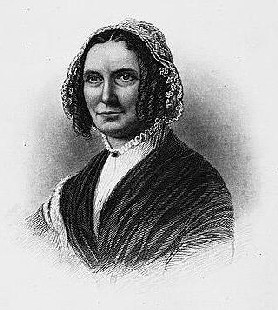
Distraught over the death of his
wife just four weeks after his presidency ended, then to make matters
worse, his daughter, Mary Abigail, died one year later during a
cholera epidemic. Dealing with these losses weighed heavily on the
former president, so to seek consolation, he traveled to Europe. In
1858, he married Caroline Carmichael McIntosh, a wealthy Albany widow,
whose income added to his own wealth, enabled them to purchase the
grandest of homes in Buffalo, New York.
The Homes of
Millard Fillmore
After Fillmore married Abigail, he
built a new home for them in 1825 in East Aurora, New York. The house
contains a stenciled living room, which moves back to the kitchen.
The upstairs children=s
room features a collection of toys and dolls from the 1800s. Some of
the furnishings throughout were owned by the Fillmore=s
and a portrait of Millard, painted in later years is displayed here.
On the grounds are several gardens and a carriage barn, which contains
a sleigh that was used by the Fillmore family.
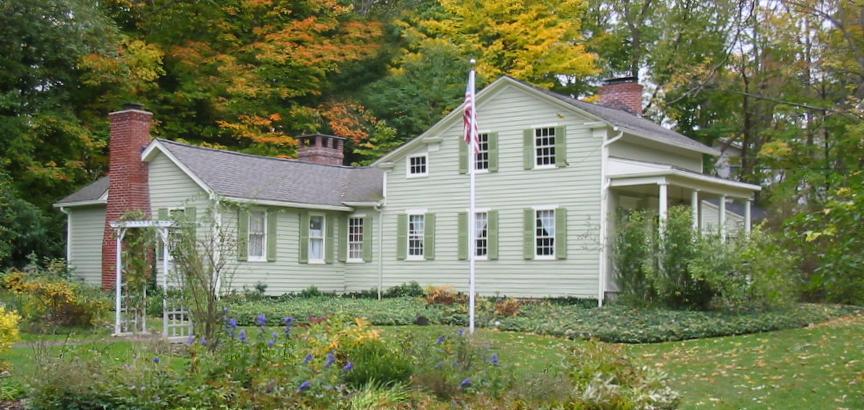
Presently the house is maintained
by the Aurora Historical Society, which purchased it in 1975. It was
the Society who restored it to its 1826 style. Extensive research was
done to uncover the original floor plans, the color of paint used, and
further interior details. Visitors today will see the house as
it originally looked when the Fillmore’s occupied it. The Society
added period furniture and other artifacts of the 19th
century to recreate the typical home of the Federal period.
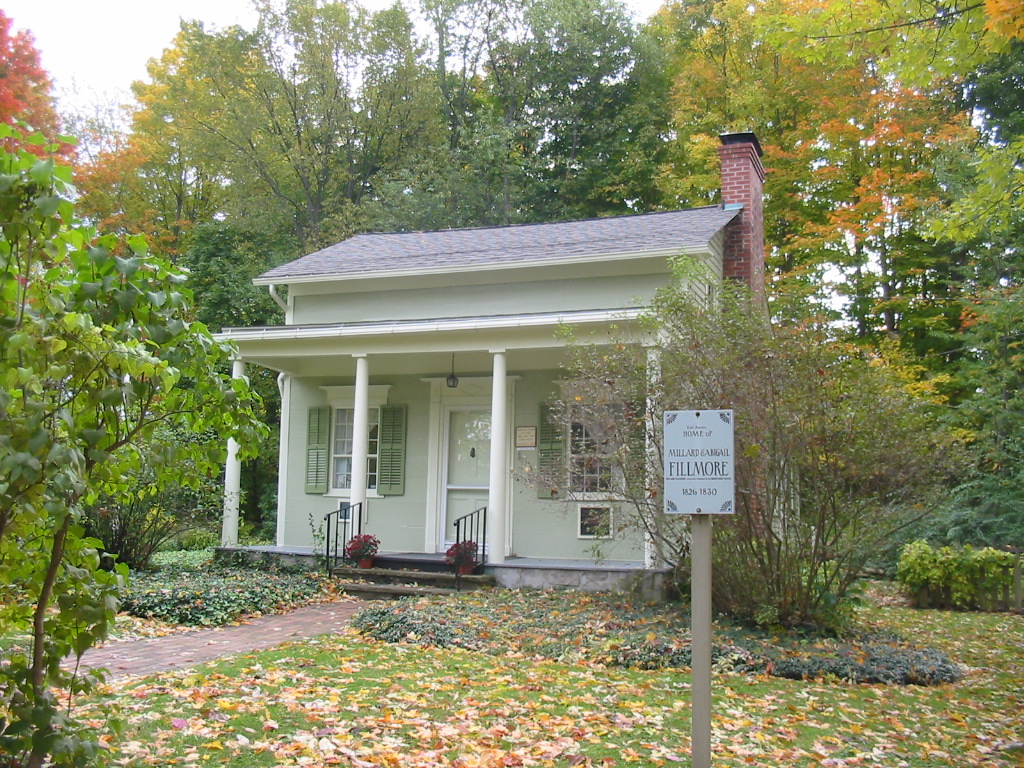
When Fillmore married Caroline in
1858, they purchased the John Hollister House at 52 Niagara Square in
Buffalo, New York. This was one of the grandest houses in
Buffalo at the time. The house, built by Hollister, also resembled the
Gothic designs of A.J. Davis, who purchased it in 1852 and lived there
until 1858. In 1858, Hollister was about to lose it when the
depression took away all his various holdings, so Fillmore bought it.
When Millard Fillmore died on March
8, 1874, the house was sold and later became a hotel. In 1919 it
was torn down to give way to the Statler Hotel.
As this house is gone, in
dedication to President Fillmore, a statue of him was erected next to
City Hall on Niagara Square in 1932, directly opposite his former
home. The inscription reads:
"Millard
Fillmore, 1800-1874, Thirteenth President of the United States,
Lawyer, Educator, Philanthropist, Statesman."
Forest
Lawn Cemetery, Buffalo, New York
Millard Fillmore is buried in
Forest Lawn Cemetery, in his family's
plot, on a gentle slope overlooking Delaware Avenue and Park Lake,
surrounded by giant shade trees. A memorial stands here; an obelisk of
pink granite that points skyward. At his grave there stands a simple
granite marker that reads only two letters, "M
F."
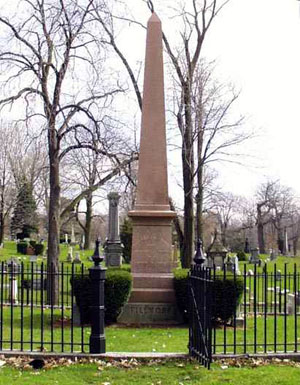
Quick Biographical
Facts:
MILLARD FILLMORE
13th President
Term- July 9, 1850 to March 4, 1853
Whig Party
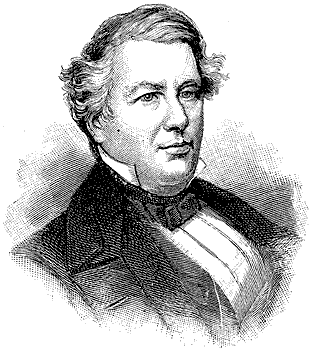
Birth: Locke,
Cayuga County, New York, January 7, 1800.
Ancestry: English
Marriage: First Marriage: Moravia,
New York, February 5, 1826 to Abigail Powers, who was born in
Stillwater, New York, March 13, 1798. Abigail died in Washington,
D.C., March 30, 1853, and is buried in Forest Lawn Cemetery, Buffalo,
New York.
Second Marriage: Albany, New York,
February 10, 1858, to Caroline Carmichael McIntosh, who was born in
Morristown, New Jersey, October 21, 1813. Caroline died at Buffalo,
New York, August 11, 1881 and is buried in Forest Lawn Cemetery,
Buffalo, New York.
Children: (by first wife): Millard
Powers (1828-1889); Mary Abigail (1832-1854).
Home: East Aurora, New York.
Education: Attended public schools;
studied law in Cayuga County and Buffalo, New York.
Religion: Unitarian
Occupation before Presidency:
Lawyer
Pre-Presidential Offices: Member of
New York Legislature; Member of U.S. House of Representatives; Vice
President.
Age at Inauguration: 50
Political Party: Whig, during
Presidency; American from 1854.
Fillmore Administration: Vice
President: None
Inauguration: July 10, 1850, Hall
of the House of Representatives, Washington, D.C.
Occupation after Presidency:
Retired
Death: Buffalo, New York, March 8,
1874.
Cause of Death: Debility at age 74.
Place of Burial: Forest Lawn
Cemetery, Buffalo, New York.
Interesting Facts:
Fillmore was the second Vice
President who succeeded to the Presidency because of the death of his
predecessor, Zachary Taylor
During Fillmore's Presidency, in
1852, Harriet Beecher Stowe's anti-slavery novel Uncle Tom's Cabin was
published. The book sold 300,000 copies the first year
The year before his death in 1874,
Fillmore founded the SPCA. He fully supported this organization and
cause, and wrote letters urging the passage of this bill, which was
enacted
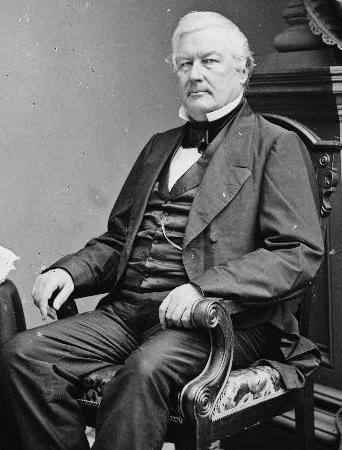
Copyright © 1992-2022 by John T. Marck. All
Rights Reserved. This article and their accompanying pictures,
photographs, and line art, may not be resold, reprinted, or
redistributed for compensation of any kind without prior written
permission from the author. Informational assistance from The White
House and Presidential Avenue. Additional information from
The Presidents of the United States, by John T. Marck.
A
Splendid Time Is Guaranteed For All
| | |
| |
|

